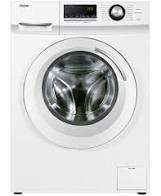Pros and Cons of Front-loaders vs Top-loading Washing Machines
A common question – which is better, top-loading or front-loading?

Midea top loader
Each type has its life-long fans. Each group is convinced that their preference is better than the other. But is the truth about top-loaders versus front-loading washing machines? Below are some thoughts so you can decide for yourself.
Some of this article is taken from the Good Housekeeping website – thanks to them for their content.
In Good Housekeeping Institute tests, both types clean so well you’ll likely not notice a difference in your clothing, though our tests show front loaders do perform a bit better.
The preference does vary around the world. For example in the UK and much of Europe, most washing machines are front-loaders whereas in Australia and New Zealand, people prefer top-loading washing machines.
Energy Efficiency?
A front-loading washing machine is the more energy-efficient option. It uses less water in each load. Clothes get cleaned when they tumble in a small pool of water that’s added by the machine once it senses the weight and type of load.
Capacity Issues
Many people think that front-loading washing machines cannot handle bigger items of laundry.
Front-loaders can easily handle big, bulky items, like comforters and sleeping bags.
Ease of Access
A top-loader is generally easier to use since there is less bending required to put the dirty laundry in the machine. However,
Most manufacturers sell pedestal drawers to raise the appliances up off the floor and save some strain on your back.
Limited Space
If you live in a small house or apartment, then a front-loader will probably be the better choice.
“…a front load washer can be stacked with its matching dryer and placed in a closet, bathroom or any narrow area where water, electrical connections and venting are available.”
More Attention To Looking After Your Machine

Haier front loader
A front-loader will need more cleaning up after you use it.
Keep in mind that water often puddles in the door gasket, dispensers and even the drum itself at the end of the cycle and can lead to mold growth and odors. If you choose a front loader, you’ll need to be diligent about cleaning the gasket and dispenser and leaving the door ajar so the drum dries out and odors don’t develop.
Water Usage
Top-loaders use more water than front-loading machines so if water consumption is a problem in your area, this may be a consideration for you.
Newer, high-efficiency top-loading washing machines provide excellent cleaning, have huge tubs for extra-large loads, and are still energy efficient even though they use more water than front loaders.
Impact On Your Clothes
Some top-loaders can have wear out your clothes quicker than front-loaders.
They can come with or without center agitators, which draw clothing through the water to clean them. Keep in mind that agitator models are a little less gentle on fabrics and get clothes cleaned by bouncing and moving them through a pool of water.
Prices
Prices depend on the brand and features but as a general rule:-
A top-loading washing machine is typically less expensive.
Potential Health Issues
One aspect that people don’t often consider is the potential for respiratory issues.
Because the water in top-loaders drains down and out, they are less likely to develop mold and odors than front-loaders are and that’s the reason many consumers prefer them. However, like with all machines, it’s a good idea to clean the tub and dispensers about once per month.
If you have either a top-loading washing machine or a front-loader, and they need attention, servicing or repairs, go to https://nzappliancerepairs.co.nz/, search for your local appliance repair company, for example, Hastings appliance repairs.
